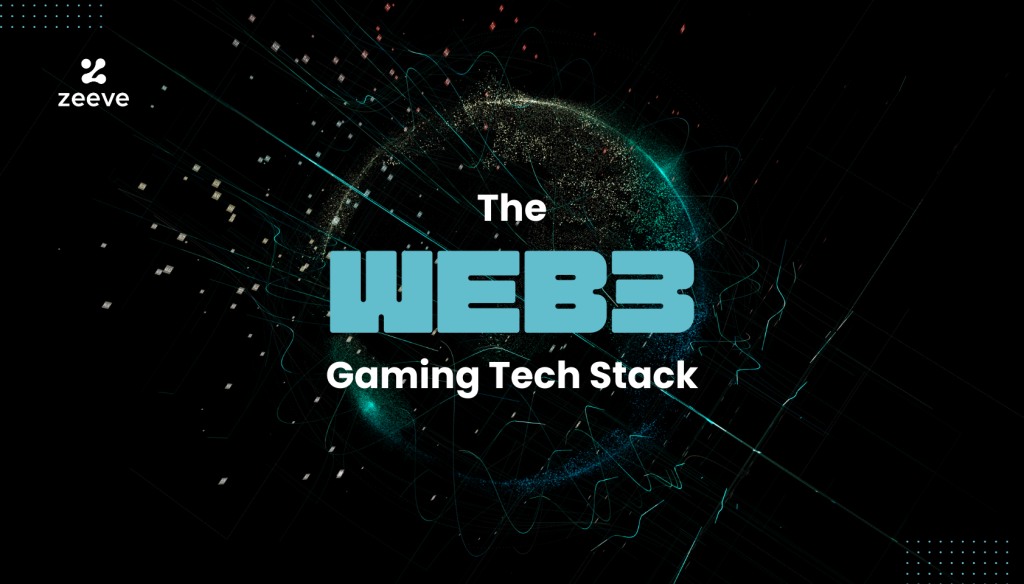With the Web3 industry growing rapidly, at 38.2% CAGR, demand for Web3 gaming has increased among gaming enthusiasts worldwide. Web3 games leverage the power of blockchain technology and a range of next-gen technologies like 3D reconstruction, NFTs, and cryptography to enable fully decentralized, highly immersive, secure, and incentive-based gaming experiences.
If you are a Web3 developer or gaming studio, looking to build an advanced game, dive deeper into the Web3 gaming tech stack, as this plays a crucial role in enabling the development of Web3 games, often referred to as play-to-earn games. This guide explains the Web3 tech stack required to build an advanced Web3 game from scratch.
However, Besides familiarity with the tech stack, developers must have hands-on experience in the Web3/blockchain domain and a solid understanding of blockchain technology, smart contracts, and the various tools and frameworks available for building decentralized applications. Before we discuss the tech stacks, let’s quickly walk through the Web3 development process.
Understanding the Web3 Game Development Process
Web3 games are yet another version of dApp running on the blockchain powered by multiple technologies. App developers with good blockchain development experience can write smart contracts and build the game dApp. However, the end-to-end process of Web3 game development involves various steps that may require inputs from everyone, from product managers and developers to marketing professionals.
Now for the web3 game dApp development, the process starts with project ideation, selection of your gaming platform-compatible blockchain network, development, feature integration, user interface design, testing, optimization, and finally, deployment.
To better understand the Web3 game development journey, we’ve outlined a 7-step process, complete with key tasks for each stage:
- Project Ideation
- Blockchain Network Selection
- Game Development
- Feature Integration
- User Interface Design
- Testing and Optimization
- Deployment
In the following sections, we’ll delve into the essential tools, tech stacks, and platforms that will streamline your development process and boost efficiency. Stay tuned as we uncover the building blocks for creating a successful Web3 gaming experience.
The Complete Web3 Gaming Tech Stack
Web3 Gaming tech stack lays down the foundation of any game-specific decentralized application, providing the developers with all the essential blockchain frameworks, infrastructures, development tools & SDKs. Powered with distributed ledgers, smart contracts, cryptography, and non-custodial wallets, development on the Web3 ecosystem demands a different set of tech stacks compared to its web2 counterpart. Check our complete list of tech stack required to build a full-fledged Web3 game:
The Right Blockchain
Blockchain provides an underlying decentralized infrastructure to Web3 games, enabling trustless behavior, speed, and decentralization while eliminating the dependency on central authorities.
That said, choosing the right blockchain is essential for properly functioning your gaming platform, as expected. You can decide the type of blockchain required based on your game’s architecture and technical requirements.
You have the option to utilize public blockchains such as Polygon, BSC, Ethereum, Solana, Tezos, Flow, and Klatyn, Arbitrum, Arbitrum Nova or you can build on application specific blockchains like Polygon Supernet and Avalanche Subnet. The key difference lies in resource allocation: with public blockchains, your game shares resources, while on application specific blockchains, the entire resource pool is dedicated to powering your gaming dApp. Factors like transaction fees, scalability, and decentralization should be carefully considered before making a decision.
Learn more on: How to Choose the Right Blockchain For Your game?
Web3 libraries
Web3 libraries are an essential developer framework that allows Web3 game developers to interact remotely and work with smart contracts, decentralized applications, and blockchain nodes. These libraries simplify the development process by abstracting away the complexity of blockchain, allowing developers to focus on building game logic and adding functionalities. Below are the popular Web3 libraries for Web3 game development:
Web3.js: This JavaScript library provides a simple interface for interacting with the Ethereum blockchain. It supports several network protocols and provides a complete set of functions for sending and receiving transactions, accessing blockchain data, and executing smart contracts.
Ether.js: This comprehensive and complete library allows developers to interact with the Ethereum ecosystem. As a general-purpose library, Ethers.js supports importing and exporting mnemonic phrases for JSON wallets and saves private keys in a secure environment.
There are few more.
When choosing a web3 library for a web3 game, developers should consider several factors, including level of developer documentation and support available, and the level of abstraction provided by the library. Additionally, you should ensure that the library is compatible with the blockchain platform you choose and can fulfill the specific requirements of the game.
APIs
APIs (Application Programming Interfaces) allow your Web3 game to communicate with the blockchain to perform the required set of functions, such as reading data from the blockchain, sending data to the blockchain, checking assets-related transactions, and so on. Following are some of the benefits game developers can leverage from APIs:
Web3 game deployment is often challenging, with developers required to configure the game ecosystem and perform complex integration consistently. The deployment effort is minimized using APIs as you do APIs integration, apply the logic, test, and then power the game with innovative, up-to-date features.
APIs enable the Web3 developers to check if an application logic is viable before deployment. Game developers can also leverage APIs to test and validate the logic worth proceeding with quickly. All these benefits of APIs contribute to the creation of Proof of Concepts (PoC) to reduce significant development and testing time while saving the overall cost and enabling faster time to market.
Adding sub-functionalities to any Web3 game, such as adding NFTs, wallet, or exchange support, requires calling various API services, which is time-consuming and complex. With specialized APIs, developers can call a range of APIs at once and add required support.
Shared APIs are the less expensive way to get data from the blockchain. But there could be API request limits, or less customization choices, impacting your dApp performance in some cases.
Nodes can be the perfect option there.

RPC Nodes
If you are developing a blockchain based game, you’ll primarily need to interact with RPC Nodes.
RPC Nodes serve as an interface between your game and the underlying blockchain network, enabling you to send transactions, execute smart contracts or Query blockchain data.
While you can run your own RPC node, it’s important to remember that doing so requires maintaining the infrastructure, updating the client software regularly, working on getting production grade performance, and constant monitoring.
Instead a 3rd party provider like Zeeve could help to save time and resources on maintenance and you could focus on developing your game.
Read more on: How Blockchain Node as a service works?
Smart Contracts Essentials
Here we have multiple programming languages, smart contract testing tools, development environments etc. They are important to enable the creation, testing and execution of programmable game logic intended for various operations.
Solidity, Vyper, Rust are among the most used programming languages used to build web3 games. Each language has its unique strengths and capabilities, so it’s important to select the one that best fits your game’s specific needs and requirements.
In addition to programming languages, utilizing the appropriate testing and development environments can significantly streamline your workflow. Tools like Hardhat, Truffle, Remix, and Brownie are commonly used in the development of Web3 games. These platforms provide invaluable resources for developers, such as debugging tools, testing frameworks, and deployment assistance, which can help ensure your smart contracts are robust, secure, and efficient.
Decentralized Wallets
Wallets play a crucial role in Web3 games, as they authenticate users’ identities via wallet addresses and grant them access to the game (dApp) ecosystem. Once verified, users can transfer digital assets to other addresses, buy and sell collectibles, and securely store their virtual possessions.
An essential feature of a decentralized wallet is its non-custodial nature, meaning the platform does not store your private key. Non-custodial wallets ensure that you maintain full ownership of your assets.
Another important aspect to consider is how easily the wallet can be integrated. Ideally, it should offer flexible integration across multiple blockchains. Plug-and-play wallets simplify integration with various blockchains, streamlining players’ ability to explore unique networks for a comprehensive account and identity management experience.
A desirable feature for wallets is a secure recovery option that preserves the pseudonymous nature and decentralization of the platform
Game Development Made Easy: Build Fast With Zeeve
Without a doubt, Web3 games are the future of online games. However, these genres of games are relatively new for players and obviously for the developers. If you are a developer looking to build your next Web3 game or port your existing game to the Web3 ecosystem, Zeeve is the perfect platform to get started and accomplish your project on customized parameters.
Zeeve equips developers with an extensive range of resources, scalable Web3 infrastructure – nodes, and APIs for building tailor-made decentralized applications. Enjoy access to flexible APIs, powerful tools, and a comprehensive library to set up your game node via a user-friendly control panel. Choose from 30+ supported public blockchains, enterprise blockchains like Polygon Edge, application specific blockchains like Avalanche L1 (Formerly known as Subnets), and Substrate chains. Our graphical dashboard enables in-depth monitoring of node resources and blockchain-level parameters.
Trusted by over 23,000 developers, 100+ institutions, and with more than 4,000 nodes deployed, Zeeve has earned the confidence of countless Web3 startups and businesses worldwide.
Want to know more about how we can help? Connect with us today and see how Zeeve can simplify your game development experience.




